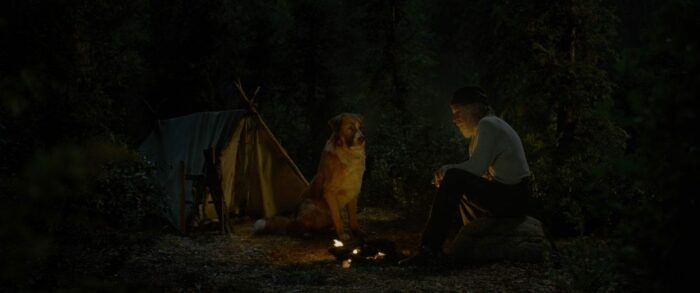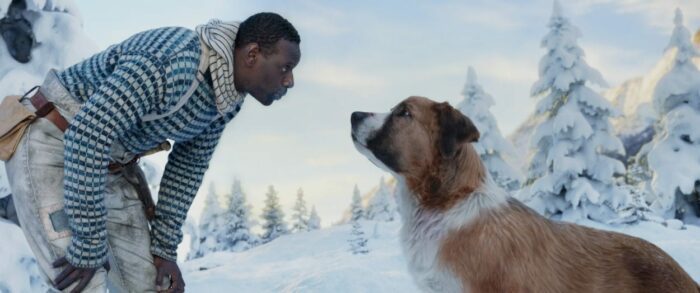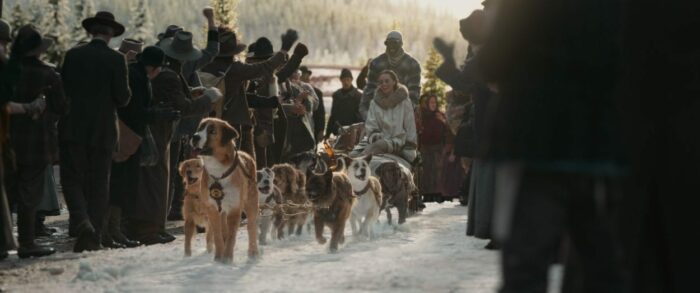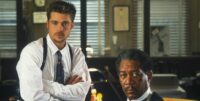
Those who have read Jack London’s 117-year-old short novel The Call of the Wild know the truth of its content. Continuously mushing through a gauntlet of abuse and arduous conditions, the story of Buck is not a cuddly one fit for a bedtime story or fireside chat. Any uplifting spirit present does not swell like your typical dog story. The spectre of a truly violent world is inescapable. Each film adaptation over the many decades, from Clark Gable and Charlton Heston to Snoopy and anime, has made their attempt to soften what cannot entirely be softened. This year’s Disney-acquired 20th Century Studios take from animation veteran Chris Sanders, producer James Mangold, and star Harrison Ford adds to that repetitive history of unremarkable failures.
London’s pup-tagonist is Buck, a beefy St. Bernard mix owned by a well-to-do and over-matched judge (Bradley Whitford) in the Santa Clara region of California in 1897. In the movie, stunt coordinator and prominent performance capture expert Terry Notary (the recent Planet of the Apes trilogy) is the movement model for the CGI creation inhabiting the screen. Pampered and undisciplined, Buck gets duped into being seized, boxed, and shipped to the markets of Seattle. With the migration of dreamers and workers for historic Klondike Gold Rush in full swing, a fresh 140-pound specimen like Buck would be an attractive acquisition of untapped talent.
Starved in that crate, Buck tries to battle his overman only to learn the conquering power hardened hickory applies to flesh and bones. Heavily off-screen compared to the detailed first-paw account in the novel, Buck is beaten into obedience where even the held appearance of such a man-made weapon elicits a trigger of feared correction. Welcome to the old ways of servitude. As the author calls it, this is the law of club.

Buck’s first Alaskan owners are the Canadian mail carrier Perrault (Omar Sy of The Intouchables) and Francois (Cara Gee of TV’s The Expanse) who harness his weighty power to a dog sled led by the fierce white husky Spitz. Happy to serve and brave to no end, Buck impresses his owners and lesser sled peers in proving his potential for leadership, much to the cunning chagrin of current front-runner. It is outdoors in these competitive stakes, that Buck is forced to rise in accordance with the next controlling force: the law of fang.
Beyond the human battery, the living and nonliving elements of Mother Nature are out to humble us all, man and dog. Buck’s gargantuan size gives him natural stamina and resilience, no doubt. But, at some point for our canine hero, the old Mark Twain adage of “it’s not the size of the dog in the fight, it’s the size of the fight in the dog” comes chomping. Buck begins to hear the titular bellows out yonder and ancestral instincts reignite in a mid-climactic Northern Lights throwdown versus Spitz.
Buck’s success is temporary as the mail service is forced to disband. A high bid shifts Buck to a trio of rich and unprepared prospectors led by the brother-and-sister team of the harsh Hal (professional movie villain and ungainly overactor Dan Stevens) and the bratty Mercedes (MCU player Karen Gillan). Mushed to the brink of abused and exhaustive death, Buck is rescued by John Thornton (Ford), the ever-present narrator of this story from the beginning.
A solid master-and-companion relationship must be properly fostered. With the burly freebooter Thornton, Buck finds tangible trust and love, the most of both he will have in his life. Lifted by Ford’s magnetic charisma (the guy is always an appealing draw) and constant dumbfounded and demure look they give the digitized dog, this lesson is the core target of substance this movie version is going for, begging for audience awwws.
If that’s what you want, or even need, dutifully shot by Spielberg’s frequent cinematographer Janusz Kaminski and backed by a Xeroxed score of spirit from How To Train Your Dragon composer John Powell, you’re going to get it, fakery and all. Did Chris from Beethoven (or his 12 doubles) not have any children or grandchildren of cinematic stock? Despite fair effort from Notary, you never reach the proper suspension of disbelief to buy Buck’s presence and that of the other featured animals. Stevens isn’t the only overactor here. The fleet of compositors and texture artists handling animal body language emotions are just as bad.
However, that tail-wagging pluck is not the highest peak of The Call of the Wild. The genuine grit of this classic stems from the survival perils and the internalized path to primitivism. This review would be glad to tout such a pair of teachable, character-building moments if the movie elevated to such a level. Alas, it does not. As a side effect to the aforementioned charisma and modesty, anything indomitable is more incorrigible instead. That result matches the fantasy adventure tone of Chris Sanders making his live-action debut after a career spanning Lilo & Stitch, How to Train Your Dragon, and The Croods. Yet, some of the most cinema-ready scenes from the novel are warped or omitted entirely.

There is an unmistakable edge to Jack London’s story that is lost when you go cute. What was sharp is made dull with cuteness for the sake of cuteness. Doing so becomes a disservice to the hard tale London sought to tell. The corporeal substance from the source material has a feral spine that should not be entirely tamed. Truth be told, the uplifting spirit of The Call of the Wild is a bleak one centered on those two reduced pillars of grit. Cute has been done before and too often, making this newest iteration a repetition of predecessor mistakes.
Echoing more honesty, though, is the reality of the marketplace this movie is leaping into. Readers of The Call of the Wild know damn well (or they should anyway) that a true adaptation of its unforgiving and violent narrative would make PETA outraged and National Congress of American Indians hyperventilate. We get it. Adorable things sell tickets that ugly things cannot. In that regard, this adaptation was always going to have those limits and weaker objectives.
Gosh, though, the impact of the redemption possible from the real monstrousness of the written page would be something powerful to experience. The full force of The Call of the Wild would go a great deal further in rattling souls and shredding heartstrings for impressionable viewers than more disposable fluff. The right writer was in place here with Logan Oscar nominee Michael Green, but punches were pulled all over the place. Like Buck searching for the answers to his innate grumblings, we too gaze about with hollow unfulfillment.



